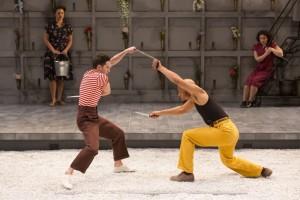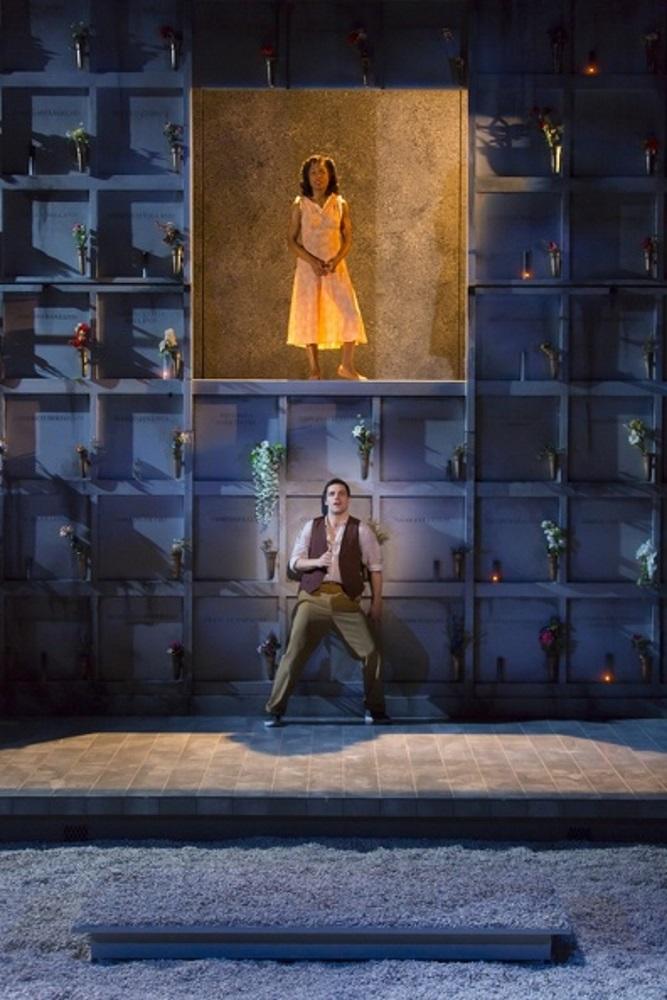These days it’s almost impossible to do Shakespeare in Elizabethan costumes. Every new production on a professional stage seems obliged to locate the play in some historical or metaphorical setting which – it is hoped – casts a new and relevant light on the classic text for contemporary audiences.
(I have no problem with this approach, by the way. As a director, I’ve done As You Like It with cell phones and iPads, The Taming of the Shrew with snatches from Kiss Me, Kate, and A Midsummer Night’s Dream stuffed with cheeky anachronisms.)
Two current productions – Romeo and Juliet at Hartford Stage and As You Like It at Britain’s National Theatre (via NT Live at Amherst Cinema) – illustrate this imperative, the urge not only to modernize Shakespeare but to go for the High Concept: an overarching context that captures the play’s heart and soul.
In Hartford, Darko Tresnjak’s “fair Verona” is post-WWII Italy, a milieu inspired by the neorealist cinema of Vittorio de Sica, Roberto Rosselini and others. In London, Polly Findlay brings As You Like It right up to date, setting the early scenes not in a cold, inhospitable ducal court but in a cold, inhospitable corporate office. Both concepts create engaging resonances for the audience, and awkward problems for themselves.
 The entire back wall of Tresnjak’s self-designed set is a mausoleum, its flower-decked interment niches stacked to the sky – a reminder of the feuding families’ losses as well as the dead in the recent war. Vaffancul’ gestures, a peasant dance and a ritualized duel underline the Veronese context.
The entire back wall of Tresnjak’s self-designed set is a mausoleum, its flower-decked interment niches stacked to the sky – a reminder of the feuding families’ losses as well as the dead in the recent war. Vaffancul’ gestures, a peasant dance and a ritualized duel underline the Veronese context.
Italian blood feuds remind us unavoidably of La Cosa Nostra, but Tresnjak doesn’t quite go there. In fact, following his cinematic inspiration, he makes the hot-tempered families part of the ordinary traffic of Verona’s streets (though Romeo’s friend Mercutio gets around town on that two-wheeled status symbol at the center of de Sica’s The Bicycle Thief). This sunlit city, though, seems at odds with the gritty black-and-white of the neorealists’ urban visions.
In this director’s concept, then, Shakespeare’s saddest tragedy – two children of privilege broken on the wheel of youthful recklessness and grown-ups’ folly – is played out within a world of t-shirts and cotton frocks, where survival and revenge are attained at knife-point.
In As You Like It, the modern office makes an interesting parallel to Shakespeare’s “envious court,” where power resides and everyone’s either jealous or suspicious of everyone else. But the setting doesn’t actually serve the action, since the scenes that take place there are, on one hand, private encounters and on the other, a wrestling match.
 The traditional vision of the play sees the court as a chilly, sterile and/or shadowy realm, which then gives way to the bright and colorful Forest of Arden. But in Findlay’s and set designer Lizzie Clachan’s view, the forest is an almost literally upside-down version of the dark, dreary office. In the transition from city to country, the desks and chairs levitate slowly to hang above the stage – no leafy canopy but a hard metallic one.
The traditional vision of the play sees the court as a chilly, sterile and/or shadowy realm, which then gives way to the bright and colorful Forest of Arden. But in Findlay’s and set designer Lizzie Clachan’s view, the forest is an almost literally upside-down version of the dark, dreary office. In the transition from city to country, the desks and chairs levitate slowly to hang above the stage – no leafy canopy but a hard metallic one.
Unlike most directors of this piece, Findlay has noticed that when we first meet the exiled duke and his followers in the woods, it’s cold – he cites “the icy fang and churlish chiding of the winter’s wind.” Not until the second half does the sunlight begin to peep through the overhanging furniture (the whole production is pretty dark) and with it come more of the play’s comic aspects.
In this director’s concept, then, Shakespeare’s sunniest comedy – where lovers come of age and stony hearts are melted under the spell of the simple life – becomes a trial by frost, an initiation ritual aimed at finding oneself, not apart from the cruel real world, but within it.
I was intrigued, but not entirely convinced, by the concepts that framed these productions. In Tresnjak’s case, as with his recent renditions of Hamlet, Twelfth Night and The Tempest, the look of the piece seemed more a striking overlay than a connective metaphor. Findlay’s even more arresting imagery brought out some often-overlooked aspects of the play, but at the cost of deep logical rifts.
As for the overall productions and performances, I found them likewise partly convincing and partly problematic. But that’s another story.
Romeo and Juliet, through March 20 at Hartford Stage, 860-527-5151, hartfordstage.org.
As You Like It on screen at Amherst Cinema March 12 at 1 p.m., 253-2547, amherstcinema.org.
Photos: Romeo and Juliet by T. Charles Erickson
As You Like It by Johan Persson
If you’d like to be notified of future posts, email StageStruck@crocker.com








